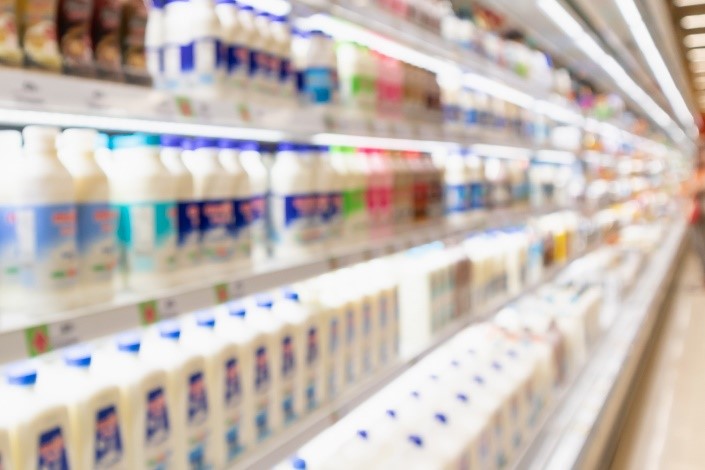New research in the Journal of Dairy Science® demonstrates that paperboard cartons—which are widely used in school meal programs—do not preserve milk freshness as well as other containers
Philadelphia, January 26, 2023 – The dairy industry strives to preserve the quality and safety of milk products while maintaining the freshest possible taste for consumers. To date, the industry has largely focused on packaging milk in light-blocking containers to preserve freshness, but little has been understood about how the packaging itself influences milk flavor. However, a new study in the Journal of Dairy Science®, published by Elsevier, confirms that packaging affects taste—and paperboard cartons do not preserve milk freshness as well as glass and plastic containers.
Lead investigator MaryAnne Drake, PhD, of the North Carolina State University Department of Food, Bioprocessing and Nutrition Sciences, Raleigh, NC, USA, explained that “milk is more susceptible to packaging-related off-flavors than many other beverages because of its mild, delicate taste.” Besides light oxidation, “milk’s taste can be impacted by the exchange of the packaging’s compounds into the milk and by the packaging absorbing food flavors and aromas from the surrounding refrigeration environment.”
To quantify the flavor impacts of packaging, the researchers examined pasteurized whole and skim milk stored in six half pint containers: paperboard cartons, three plastic jugs (made from different plastics), a plastic bag, and glass as a control. The milk was stored in total darkness to control for light oxidation and kept cold at 4°C (39°F).

Caption: Milk is available in various packaging, including plastic jugs, paperboard cartons, and glass jars Credit: iStock.com/Kwangmoozaa).
The samples were tested on the day of first processing, then again at 5, 10, and 15 days after. A trained panel examined the sensory properties of each sample, and the research team conducted a volatile compound analysis to understand how the packaging was intermingling with the milk. Finally, the samples underwent a blind consumer taste test on day 10 to see whether tasters could tell any difference between milk stored in the paperboard carton or the plastic jug compared with milk packaged in glass.
The results showed that package type does influence milk flavor, and skim milk is more susceptible to flavor impacts than whole milk. Of the different packaging types, paperboard cartons and the plastic bag preserved milk freshness the least due to the paperboard’s absorption of milk flavor and the transfer of paperboard flavor into the milk. Milk packaged in paperboard cartons, in fact, showed distinct off-flavors as well as the presence of compounds from the paperboard. The final results show that, while glass remains an ideal container for preserving milk flavor, plastic containers provide additional benefits while also maintaining freshness in the absence of light exposure.

Caption: Paperboard cartons are the most widely used milk containers for school meal programs (Credit: iStock.com/ bonniej).
Paperboard cartons are the most widely used packaging type for school meal programs in the United States, so these findings are especially relevant for the consideration of how young children consume and enjoy milk.
“These findings suggest that industry and policymakers might want to consider seeking new package alternatives for milk served during school meals,” said Drake. Over time, the consequences of using milk packaging that contributes significant off-flavors may affect how young children perceive milk in both childhood and adulthood.
Notes for editors
The article is “The role of packaging on the flavor of fluid milk,” by Dylan C. Cadwallader, Patrick D. Gerard, and MaryAnne Drake (https://doi.org/10.3168/jds.2022-22060). It appears in the Journal of Dairy Science, volume 106, issue 1 (January 2023), published by FASS Inc. and Elsevier.
The article is openly available at https://www.journalofdairyscience.org/article/S0022-0302(22)00642-7/fulltext and the PDF version is available at https://www.journalofdairyscience.org/action/showPdf?pii=S0022-0302%2822%2900642-7.
Journalists wishing to interview the authors should contact the corresponding author, MaryAnne Drake, Department of Food Science, Food, Bioprocessing and Nutrition Sciences, North Carolina State University, at mdrake@ncsu.edu.
About the Journal of Dairy Science
The Journal of Dairy Science® (JDS), an official journal of the American Dairy Science Association®, is co-published by Elsevier and FASS Inc. for the American Dairy Science Association. It is the leading general dairy research journal in the world. JDS readers represent education, industry, and government agencies in more than 70 countries, with interests in biochemistry, breeding, economics, engineering, environment, food science, genetics, microbiology, nutrition, pathology, physiology, processing, public health, quality assurance, and sanitation. JDS has a 2021 Journal Impact Factor of 4.225 and five-year Journal Impact Factor of 4.987 according to Journal Citation Reports™ (Source: Clarivate™ 2022). www.journalofdairyscience.org
About the American Dairy Science Association (ADSA®)
The American Dairy Science Association (ADSA) is an international organization of educators, scientists, and industry representatives who are committed to advancing the dairy industry and keenly aware of the vital role the dairy sciences play in fulfilling the economic, nutritive, and health requirements of the world's population. It provides leadership in scientific and technical support to sustain and grow the global dairy industry through generation, dissemination, and exchange of information and services. Together, ADSA members have discovered new methods and technologies that have revolutionized the dairy industry.www.adsa.org
About FASS Inc.
Since 1998, FASS has provided shared management services to not-for-profit scientific organizations. With combined membership rosters of more than 10,000 professionals in animal agriculture and other sciences, FASS offers clients services in accounting, membership management, convention and meeting planning, information technology, and scientific publication support. The FASS publications department provides journal management, peer-review support, copyediting, and composition for this journal; the staff includes several BELS-certified (www.bels.org) technical editors and experienced composition staff. www.fass.org
About Elsevier
As a global leader in information and analytics, Elsevier helps researchers and healthcare professionals advance science and improve health outcomes for the benefit of society. We do this by facilitating insights and critical decision-making for customers across the global research and health ecosystems.
In everything we publish, we uphold the highest standards of quality and integrity. We bring that same rigor to our information analytics solutions for researchers, health professionals, institutions and funders.
Elsevier employs 8,700 people worldwide. We have supported the work of our research and health partners for more than 140 years. Growing from our roots in publishing, we offer knowledge and valuable analytics that help our users make breakthroughs and drive societal progress. Digital solutions such as ScienceDirect, Scopus, SciVal, ClinicalKey and Sherpath support strategic research management, R&D performance, clinical decision support, and health education. Researchers and healthcare professionals rely on our over 2,700 digitized journals, including The Lancet and Cell; our over 43,000 eBook titles; and our iconic reference works, such as Gray's Anatomy. With the Elsevier Foundation and our external Inclusion & Diversity Advisory Board, we work in partnership with diverse stakeholders to advance inclusion and diversity in science, research and healthcare in developing countries and around the world.
Elsevier is part of RELX, a global provider of information-based analytics and decision tools for professional and business customers. www.elsevier.com